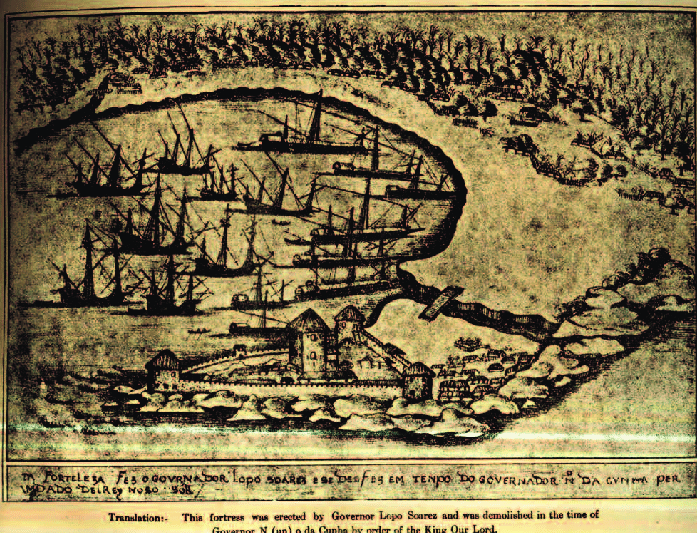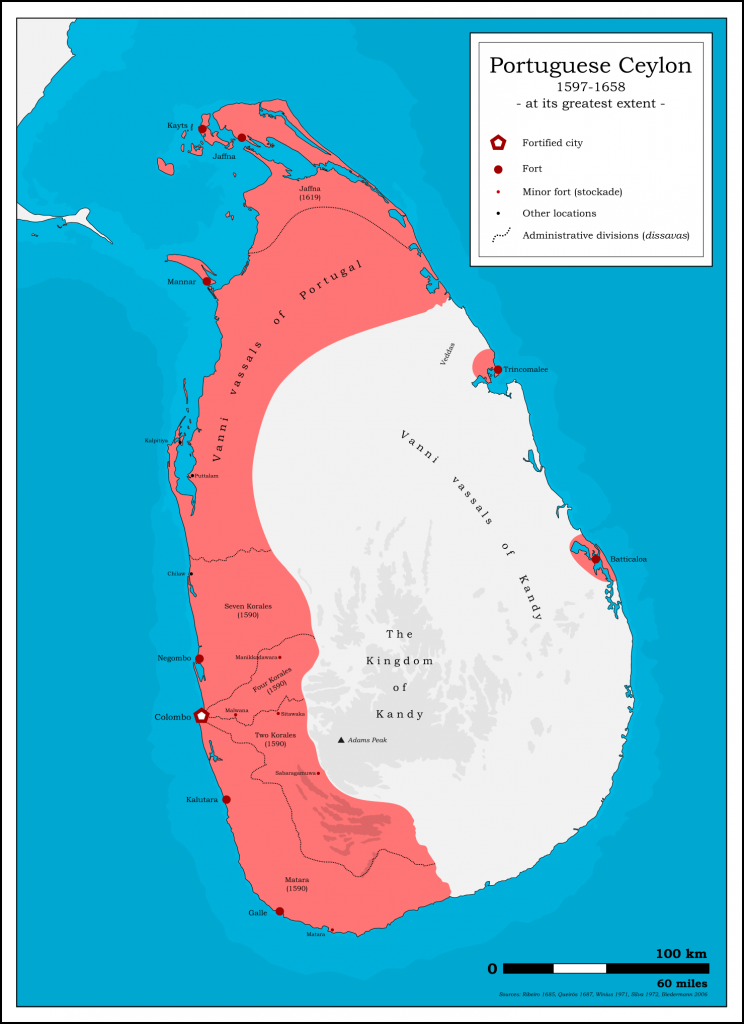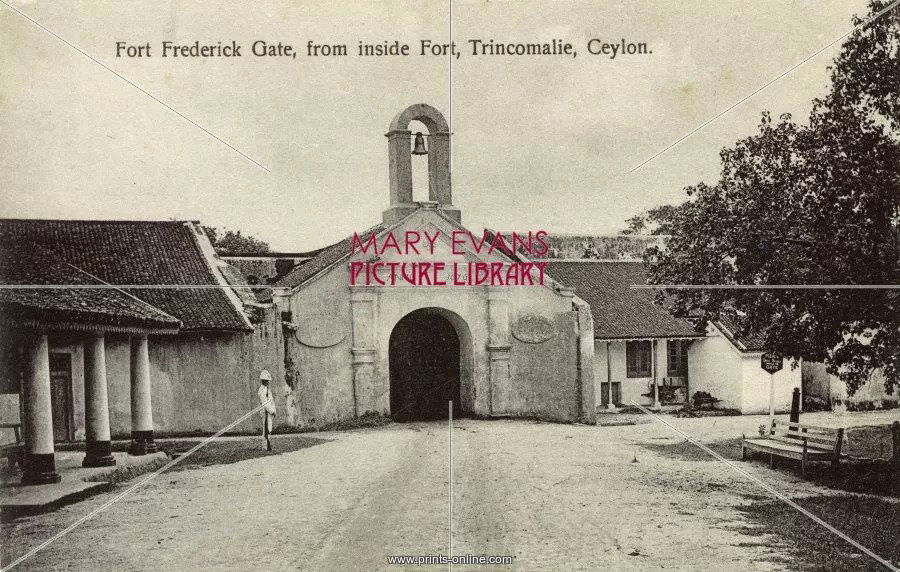In 1505, ships of the fleet of the first Portuguese to visit Ceylon, with Dom Lourenco de Almeida, were accidentally blown into the Port of Galle. In the last months of that year Dom Lourenco’s fleet anchored off Colombo and a memorial of this first landing called a “Padrao” with a cross above the Royal Arms of Portugal surmounting it, was erected on a boulder overlooking the Bay of Colombo.
They entered into a treaty with the King of Kotte and built a factory to process cinnamon that was in abundant supply. In 1518, the Viceroy Lopo Soares de Albergaria landed at Colombo with a large fleet and began building a small triangular fort named “Noosa Senhora das Virtudes” or “Santa Barbara”.

Portuguese Caravel 


In 1524 they dismantled it and kept an agent in the island under the protection of the Sinhalese King of Kotte. They established royal monopolies in cinnamon, pepper and musk. Giving up Colombo was a mistake as the colony of Muslim merchants immediately attempted to win back their supremacy in the Kingdom of Kotte and to re-conquer the cinnamon trade. However, they were defeated by the Portuguese still present on the island.
The Mappillas (Malabar Muslims), who up to 1539 nourished a dynastic conflict in the Kingdoms of Sitawaka and Kotte, opposed the Portuguese until in 1538 at Vedelai, Martin Afonos de Sousa and in 1539, Miguel Ferreira at Negombo, defeated the Mappillas and took away their cinnamon trade.
In 1500, there were three kingdoms in Ceylon, Vira Parakrama Bahu (1484-1509) was the King of Kotte in the South-west, Senasammata Vikrama Bahu (1469-1511) was King in the Hill Country and Pararajasekeran (1469-1511) was the King of the Tamil Kingdom in the North-East.
Before the arrival of the Portuguese, the kings of Ceylon were facing a Muslim Arab invasion from the West and a Mogul invasion from the East. Ceylon was under the protection of China and Sinhalese kings were paying Kappam (bribes) just before the Portuguese came.
The Portuguese presence was a blessing in disguise as they hunted down and wiped out the Muslim Arabs throughout the island and the Chinese parasitism in Ceylon came to a halt. With the encouragement of the King of Kotte, the missionaries began the work of converting the peoples of Ceylon to Christianity and churches were built in the fishing villages on the western coast. It was a time of almost constant warfare, especially against the Kandyan Kingdom, which resisted strongly the Portuguese attempts to promote Roman Catholicism. The main export commodities also included cardamoms, sandalwood, arecanuts, ebony, elephants, ivory, pearls and small quantities of tobacco, silk and kapok.

St. Don Bosco Church, Wattala
In 1544, the King of Jaffna massacred more than 600 Christians in the island of Mannar. However, in 1545, when the Portuguese threatened retaliation, the King of Jaffna submitted and paid tribute to the Portuguese. In October 1550, the Viceroy Afonso de Noroha arrived in Ceylon and sacked Sitawaka with 500 Portuguese soldiers who were stationed at Kotte. But the Viceroy lost a good opportunity of establishing the supremacy of Portugal over the entire island by not stationing soldiers in the captured towns. The treaty was renewed with the King of Kotte and in 1551 the Portuguese assumed the role of Protector of the Kotte Kingdom.
In November 1554, Duarte de Eca with 500 soldiers built a new fortress in Colombo. In 1556, 70,000 people who lived in the communities of fishermen on the sea coast north and south of Colombo were converted to Christianity. The King of Kotte, Dharmapala was re-christened as Dom Joao Perya Bandara and the Queen re-christened as Dona Catherina. Following the king’s example a few nobles adopted the Portuguese title of Dom (Sir), the Portuguese manners and language.

(Comprehensive Atlas of the Dutch United East India Company Vol. IV)
(National Archives/Charles Blackwood)
In 1560, Viceroy Dom Constantino de Braganca with 1,200 men conquered the town of Nallur, the capital of the Kingdom of Jaffna, and soon after proceeded to the island of Mannar where a fort was built. In July 1565, the Portuguese transferred their Court and Capital from Kotte to Colombo. The conversion to Christianity had alienated the majority of Sinhalese on the west coast who then surrounded the Portuguese at Colombo. In 1574, the Portuguese took the offensive and they plundered Negombo, Kalutara and Beruwela and drove out the Sinhalese garrisons at Nagalagama and Mapane and ravaged the districts of Weligama and Chilaw.
In 1587, Raja Sinha, the King of Kandy and Sitawaka began a siege of Colombo. The fort was protected by fortifications with 12 bastions that the Sinhalese assaulted many times but always failed. In February 1588, they abandoned the siege and until the end of the seventeenth century the Portuguese were masters of the coastal forts of Colombo, Galle, Kalutara and Negombo.


Demolition of the Fort, Colombo c.1865 
1665 Map of Negombo fort 
Remains of Negombo Fort 
Gall Fort between 1640 and 1667 

Vintage engraving of Galle Fort
In 1591, Andre Furtado de Mendoca invaded Jaffna and set up a new king at Nallur. The Portuguese also attempted to occupy Kandy but were met with failure.
In 1597, the Portuguese began to fortify Galle. The same year, King Dom Joao Dharmapala died without heirs and in accordance with his Will his Kingdom was donated to the King of Portugal. Thus, King Philip of the then united Kingdoms of Spain and Portugal was proclaimed the King of Ceylon and the whole territory of the Kingdom of Kotte, only Kandy was still not under Portuguese rule.
The Portuguese then attempted to unify the island under their control. In 1603, Dom Jeronimo de Azevedo attempted to occupy the abandoned fort at Balane, the key to Kandy, however a few days later he was forced to withdraw and the fort was lost. In 1611, De Azevedo marched with 700 Portuguese and Lascarins to Kandy, re-taking the Fort at Balane, where he left a garrison. He was also unsuccessful in taking Kandy, which he then proceeded to burn and the King of Kandy submitted himself to the Portuguese. Although not destroyed, the Kingdom of Kandy had been neutralized.
In 1621, the Tamil Patriarch and Pretender to the Throne Cankli Kumaran fought the Portuguese forces under the command of Felipe De Oliveriya and were defeated. The soldiers destroyed hundreds of Hindu temples and left the Tamil kingdom in ruins. The Tamils thereby lost their kingdom, their sovereignty, independence and homelands.
In 1624, the Portuguese occupied and fortified Trincomalee.

In 1630, Dom Constantino de Sa, under pressure from the Viceroy, began a march with a small Portuguese army of 400 Portuguese soldiers, 200 Portuguese Casados (married men of the army reserve) and about 4,400 Lascarins to attack the Capital of King Senarata at Badulla by crossing the jungles of Uva.
They sacked and burnt the deserted town, but on the return to Colombo, were attacked by the Sinhalese and nearly 4,000 Lascarins deserted the Portuguese and joined the enemy. For the Sinhalese this was a decisive victory from which only 130 men survived and surrendered. After this victory, King Senarat captured Saparagamuwa and set Colombo under siege, but after three months the Sinhalese army was forced to withdraw.
Thereafter, the Portuguese occupation of the country that was to last 150 years under a military form of government where martial law chiefly prevailed was weakened and vulnerable to the Dutch forces.
The Portuguese were from the beginning (Alfonso de Albuquerque) the first to experiment a colonization based on colonies of Portuguese citizens “Casados”. Since the Portuguese women were few, mixed marriages were encouraged between the Portuguese and Asians. Albuquerque tried to create a new Portuguese nation in Asia to make up for the lack of people from Portugal. This method of settlement was extremely successful.
After a century of this colonization, in practically every outpost of the empire, there were colonies of mixed Portuguese, that spoke Portuguese, were Catholic and were better suited to the tropical climates that the European born Portuguese. Thanks to this strategy, the Portuguese succeeded in withstanding the siege of the Dutch in Ceylon for sixty years.

17th Century wood carving of Portuguese soldier at Embekke Devale
(Photography Nihal Fernando)
Sketch of baila dancers from frescoes at the Purvarama Vihara, Kataluwa (1886) 
Two figures in the Kaffirhina dance by J. L. K. van Dort (late 19th Century)
The Portuguese left a Eurasian community (Portuguese Burghers) with surnames like Perera, Silva, Pieris, de Mel, de Soysa, etc. The Roman Catholic religion, Music (Baila), dress, food and Titles such as Sinno, Dona, Don, etc. and a Portuguese Creole language, a dialect of which until recently was spoken by people of mixed African descent who are descended from a Portuguese regiment of soldiers from Mozambique who settled in the village of Sellankandal near the town of Puttalam, sometime in the seventeenth century.
Credit – Wikipedia, Chryshane Mendis, 94 • LIFESTYLE, Colombo Fort, The National Trust Sri Lanka, Galle Fort, Serendib



















Loading…
Loading…